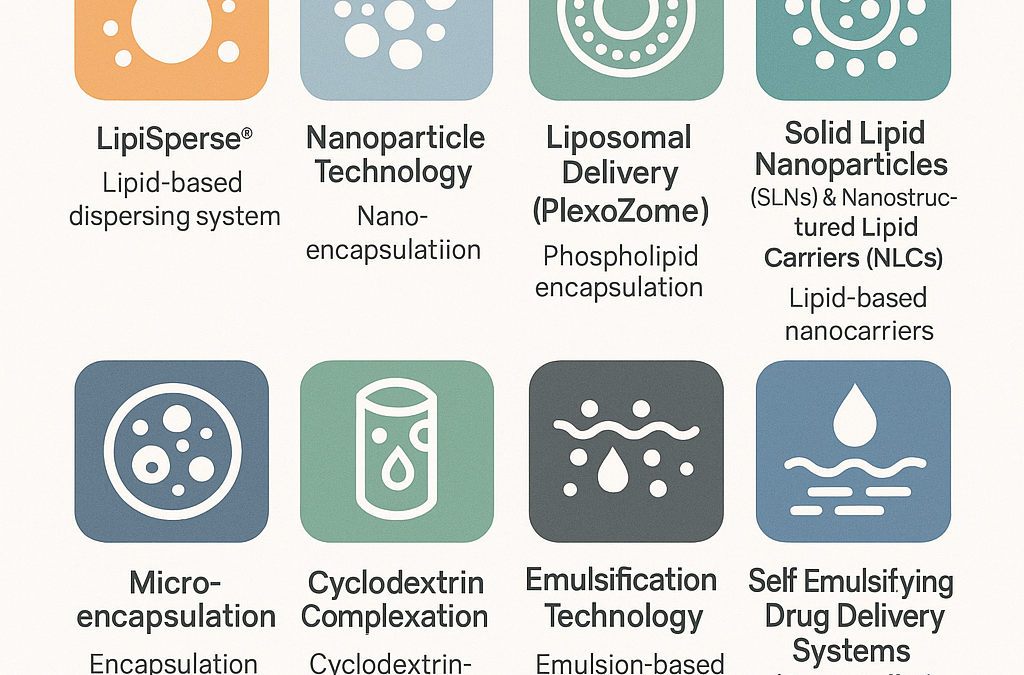As supplement innovation progresses, new delivery technologies are emerging to improve bioavailability, stability, and consumer experience. Many ingredients, especially fat-soluble, poorly absorbed, or prone to degradation, require specialized delivery systems. Below are some of the most advanced technologies to optimize supplement efficacy and convenience.
LipiSperse®
Technology Type: Lipid-based dispersing system
How It Works:
Developed by Pharmako Biotechnologies, LipiSperse® is a dispersion technology designed to enhance the solubility and bioavailability of hydrophobic (fat-soluble) ingredients like curcumin and resveratrol.
It reduces particle aggregation, allowing better dispersion in liquids and improved absorption in the gut.
Applications:
Used in powders, capsules, and functional beverages.
Ideal for curcumin, resveratrol, astaxanthin, and CoQ10.
Challenges Solved:
Overcomes poor water solubility.
Enables higher absorption without the need for black pepper (piperine) or fats.
Nanoparticle Technology
Technology Type: Nano-encapsulation
How It Works:
Reduces particle size to the nanometer scale, increasing surface area and enhancing solubility and absorption.
Can be used to encapsulate fat-soluble or poorly absorbed compounds in water-friendly forms.
Applications:
Used in curcumin, omega-3s, vitamins (D, E, K), and herbal extracts.
Found in functional beverages, liposomal liquids, and nano-emulsions.
Challenges Solved:
Increases bioavailability of hydrophobic ingredients.
Improves stability and prevents premature degradation.
Liposomal Delivery (PlexoZome®)
Technology Type: Phospholipid encapsulation
How It Works:
Uses phospholipids to encapsulate active ingredients, mimicking cell membranes to improve absorption.
Protects ingredients from stomach acid degradation, ensuring better delivery into cells.
Applications:
Common for vitamin C, glutathione, CoQ10, curcumin, and CBD.
Used in liquid supplements, softgels, and functional beverages.
Challenges Solved:
Protects unstable ingredients from degradation.
Increases bioavailability of water- and fat-soluble compounds.
Solid Lipid Nanoparticles (SLNs) & Nanostructured Lipid Carriers (NLCs)
Technology Type: Lipid-based nanocarriers
How It Works:
SLNs and NLCs use lipid particles to encapsulate active compounds, enhancing their stability and absorption.
Protects sensitive compounds from degradation while improving their delivery to target cells.
Applications:
Used for omega-3s, polyphenols, vitamins (D, E, K), and plant-based bioactives.
Found in capsules, functional foods, and topical applications.
Challenges Solved:
Enhances the stability of unstable compounds.
Improves fat-soluble nutrient absorption in water-based formulations.
Microencapsulation
Technology Type: Encapsulation for controlled release
How It Works:
Active ingredients are coated in a protective shell (e.g., polysaccharides, proteins, or lipids) to enhance stability and control release timing.
Protects against environmental factors like heat, moisture, and stomach acid.
Applications:
Used for probiotics, iron, omega-3s, and fat-soluble vitamins.
Found in functional foods, beverages, and chewables.
Challenges Solved:
Extends shelf life of sensitive ingredients.
Prevents unpleasant taste and odor (e.g., fish oil in functional foods).
Cyclodextrin Complexation
Technology Type: Cyclodextrin-based molecular encapsulation
How It Works:
Cyclodextrins (sugar-based molecules) create a “cage” around active ingredients, improving solubility and stability.
It helps mask unpleasant flavors and odors.
Applications:
Used for resveratrol, curcumin, astaxanthin, and CoQ10.
Common in capsules, powders, and beverages.
Challenges Solved:
Enhances solubility and bioavailability of fat-soluble ingredients.
Reduces oxidation and degradation.
Emulsification Technology (Micro & Nano-Emulsions)
Technology Type: Emulsion-based solubility enhancement
How It Works:
Breaks down oil-soluble ingredients into tiny droplets dispersed in water, improving absorption.
Can be used in both water- and oil-based supplements.
Applications:
Omega-3s, CBD, curcumin, and lutein.
Found in functional beverages, softgels, and RTDs.
Challenges Solved:
Prevents ingredient separation in liquids.
Improves bioavailability without the need for excessive fat intake.
Self-Emulsifying Drug Delivery Systems (AquaCelle®)
Technology Type: Self-emulsifying lipid carriers
How It Works:
It uses lipid-based formulations that automatically form emulsions in the digestive system, enhancing the absorption of fat-soluble ingredients.
Applications:
Common for CoQ10, curcumin, vitamin D, and astaxanthin.
Found in softgels and liquid supplements.
Challenges Solved:
Enhances the solubility of poorly absorbed ingredients.
Allows for better formulation of fat-soluble compounds in low-fat diets.
Enteric-Coated & Delayed-Release Capsules
Technology Type: Acid-resistant coating
How It Works:
Capsules are designed to withstand stomach acid, releasing the active ingredients in the intestines where absorption is optimized.
Applications:
Probiotics, enzymes, and pH-sensitive compounds like omega-3s and iron.
Used in pharmaceutical-grade supplements.
Challenges Solved:
Protects ingredients from stomach acid degradation.
Ensures live probiotic delivery to the gut.
As supplement science progresses, these technologies are transforming the delivery, absorption, and utilization of ingredients in the body. Whether through nanoparticle technology, emulsions, or microencapsulation, brands are discovering innovative methods to enhance supplement efficacy while improving the consumer experience.


